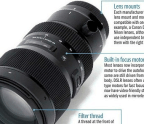
The physical size of the sensor is a very important consideration when you’re selecting a camera. As well as the cost implications (larger sensors cost more than smaller ones), it has an impact on the size and weight of the camera body, and the lenses you mount on it. That in turn affects how keen you are to carry the kit and where you want to use it. But that’s not all: the sensor size influences the quality and nature of the results that you get and you may need to use different settings with different formats to get the images that you want. Over the next few pages, we help you make an informed choice about the right camera format for you and your photography, with case studies from readers.
Micro Four Thirds
THESE are currently made by OM System and Panasonic, guided by what is known as an ‘open standard’, which means that the design specification is available for manufacturers who want to produce new cameras or lenses.
The Four Thirds-type sensor in a Micro Four Thirds camera typically measures 17.3x13mm. That’s the smallest sensor currently available in an interchangeable lens camera, and it plays a part in making many of the cameras small and portable. What’s even more significant for many photographers, however, is its impact upon the lenses because there’s a 2x focal length magnification factor. This means that a 300mm lens, for example, produces images that look as if they have been captured with a 600mm lens on a full-frame camera. That’s great news for wildlife and sports photographers, because as well as being more affordable, a 300mm f/4 lens is much lighter to carry and easier to hold for a long period of time than a 600mm f/4 lens. Of course, it means that if you want to shoot wideangle landscapes, you’ll need a shorter focal length lens than you’d usually select for a full-frame camera.
One thing to keep in mind when shooting with a Micro Four






